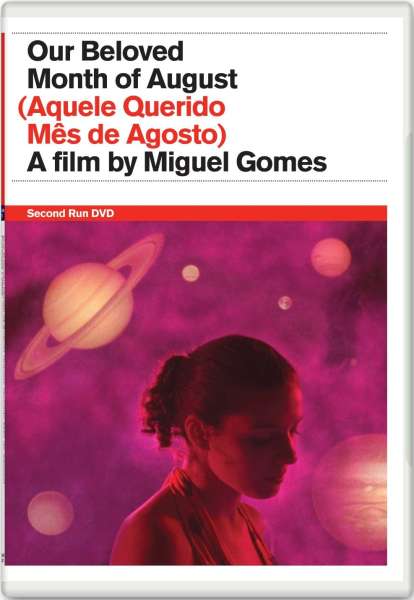|
The Film

Itís safe to say that Our Beloved Month of August is an unusual film. Beyond that, itís hard to pin down.
In one sense it is simply a documentary with rural Portugal and its inhabitants as its subject. Miguel Gomes films without narration or even interference of any kind and instead we just have people talking, sometimes to the camera, sometimes just to each other, framed by the beautiful Portugal landscape. Gomes favours as little editing as possible, with long shots, usually static, but occasionally daring to pan. The emphasis is on the filmmaker being invisible so what we are seeing is as close to possible as Ďfly on a wallí. We seem to be following local bands playing in different towns and steadily a story builds. For instance, we hear about a man who has become some sort of celebrity after he jumped in the river from a bridge; exactly why he did this and just how much of a celebrity he actually is depends on several different viewpoints, which are presented naturally so you come to your own conclusions. Meanwhile we come to learn more about the town and its dependency on fire wardens, who man lookouts and raise the alarm if smoke is spied. One of these wardens is a girl who also sings in one of the bands.
Meanwhile, the languid, almost invisible style of the film is occasionally interrupted by the film-makers themselves and this is where things become rather less straightforward! For instance, just a couple of minutes in, after we have briefly seen a band playing in the town, we see the crew arranging a domino display in a hut. The door is opened, the dominos fall and the camera follows the display, complete with edits. This is the opening shot of the film, a finely constructed set-piece at odds with the naturalistic tone of the documentary. When the display has completed, the director complains that it has been ruined. He planned to use it as the opening shot of the film. Which it is!
Yes, in a deadpan comedy of irony with echoes of Felliniís 8Ĺ, we are watching the making of the very film we are already watching. It can be very funny and I particularly love the philosophical closing shots, of the director arguing with the sound man that heís recording music no-one else can hear (except us of course)! Ok, I know that sounds dangerously close to pretentious, but even if you think it is, itís worth seeing.
Slowly, over the course of watching the bands play we start to focus on several people, like the girl in the band who is also one of the fire wardens. We learn about her close relationship with her father and the mysterious disappearance of her mother. We see her and her friend flirt with the guitarist, and in the most graceful fashion, the mischievous narrative has gently evolved into a scripted, edited drama. These people are actors (in one of those ironic asides, we even saw one arguing about what scene he was supposed to do, long before we met his character) and this is now a love story. Itís a good one too. Sůnia Bandeira who plays the attractive T‚nia is fantastic, capturing your attention, even though you thought you were watching a documentary. That you donít feel short-changed by either side of the film is testament to the skill in which it is woven together.
I had found some elements of the documentary frustrating. Occasionally you might wonder what the point of a particular long shot is, considering there is seemingly no political or social agenda, and the music can be infuriating. It seems all Portuguese folk music has the same melody with overly dramatic lyrics about love, lost love, obsessive love and marriage in between! But this just makes the drama all the more convincing when it arrives.
This shouldnít work, but it does. Gomes is like a magician, showing us openly how his trick is done, yet still the trick catches us out. The notes in the accompanying booklet suggest the film was intended to be fiction, but delays meant Gomes and some of his crew were stranded for a time, so he just started filming what he saw, hence the documentary. Iím not sure whether to believe him, but accident or not, his film is a masterful demonstration of what can be achieved in film narrative. It makes for a fascinating end-point of the methods first explored in Italian Neo-Realism.
Video
The 1.66:1 anamorphic digitally transferred image is consistent throughout. As you might imagine though, this is film that benefits from a lack of embellishment. Portugal is beautiful, but this isnít a travelogue nor a staged drama. Itís detailed, with excellent contrast and a range of naturally lit locations. Not a demo disc, but youíll come away believing youíve seen something of the real Portugal, which is more important.
Audio
As with the photography, there is no effort to create a staged sound for the film, it is all natural. Although a film full of music, it isnít an enhanced recording. It is just as if you were stood watching them yourself. There is a single, Portuguese 2.0 stereo track (with some English/French) with selectable English subtitles.
Extras
As well as standard scene selection and the trailer, there is Miguel Gomesí 2006 short film (21 minutes), ďCanticle of All Creatures (Cantico Das Criaturas). Itís a powerful demonstration of his visual style. Also included is a 16 page booklet which offers some valuable insight.
Overall
What sort of a film is August exactly? No idea, but the transition from documentary to fiction is superbly done, strangely moving and memorable. It may be youíll fear it is contrived, but it is so gentle and honest that even the playful scenes with the film crew convince.
| The Film: B+ |
Video: C+ |
Audio: C |
Extras: C |
Overall: B |
|


